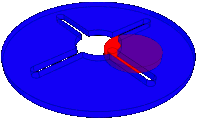Geneva drive
This article needs additional citations for verification. (September 2017) |

The Geneva drive or Geneva mechanism is a gear mechanism that translates a continuous rotation movement into intermittent rotary motion.
The rotating drive wheel is usually equipped with a pin that reaches into a slot located in the other wheel (driven wheel) that advances it by one step at a time. The drive wheel also has an elevated circular blocking disc that "locks" the rotating driven wheel in position between steps.
History

The name, Geneva drive, is derived from the device's earliest application in mechanical watches, which were popularized in Geneva.[1] The mechanism is frequently used in mechanical watches, since it can be made on a small scale and is able to withstand substantial mechanical stress.
The Geneva drive is also called a "Maltese cross mechanism" due to the visual resemblance when the rotating wheel has four spokes.
In the most common arrangement of the Geneva drive, the client wheel has four slots and thus advances the drive by one step at a time (each step being 90 degrees) for each full rotation of the master wheel. If the steered wheel has n slots, it advances by 360°/n per full rotation of the propeller wheel. The minimum number of slots in a practical Geneva drive is 3; it is rare to find a mechanism with more than 18 slots.[2]
Because the mechanism needs to be well lubricated, it is often enclosed in an oil capsule.[citation needed]
Uses and applications

One application of the Geneva drive is in film
Geneva wheels having the form of the driven wheel were also used in mechanical
Other applications of the Geneva drive include the pen change mechanism in
A Geneva drive was used to change filters in the Dawn mission framing camera used to image the asteroid 4 Vesta in 2011. It was selected to ensure that should the mechanism fail at least one filter would be usable.[4][5]
Internal version
A variant exists where the drive wheel is inside the driven wheel. While an external Geneva drive advances the driven wheel one step in less than 180° rotation of the drive wheel, so (assuming a constant-speed drive wheel) the stop is always longer than the motion, in an internal wheel the motion always requires more than 180° rotation of the drive wheel, so the motion takes longer than the stop. The axis of the drive wheel can have a bearing only on one side.
-
Internal Geneva drive
-
Animation showing an internal Geneva drive in operation
The external form is the more common, as it can be built smaller and can withstand higher
Spherical version
Another variant is the spherical Geneva drive.[3]: 128
-
Spherical Geneva drive
Kinematics

The figure shows the motion curves for an external four-slot Geneva drive, in arbitrary units. A discontinuity appears in the acceleration when the drive pin enters and leaves the slot, occurring at the instant the rigid bearing surfaces make contact or separate. This generates an "infinite" peak of
See also
- Dwell cam
References
- ISSN 0097-5834. Archived from the originalon March 25, 2018.
- ^ "Geneva mechanism | Cam-operated, Indexing, Ratcheting | Britannica". www.britannica.com. 20 July 1998. Retrieved 2023-12-28.
- ^ ISBN 0-8311-1091-0.
- US: Jet propulsion laboratory, Nasa.
- ISBN 9781461449034.
Further reading
- Sclater, Neil (2011), "Cam, Geneva, and Ratchet Drives and Mechanisms", Mechanisms and Mechanical Devices Sourcebook (5th ed.), New York: McGraw Hill, pp. 180–210, ISBN 978-0-07170442-7. Drawings and designs of various drives.
External links
- Geneva Mechanism: its history, function, and weaknesses, The University of Nebraska.
- External Geneva drive (animation), Brock eng.
- U.S. patent 6,183,087 – Quickermittent. Modified starwheel for fast pulldown.
- "LEGO Geneva Mechanism", Brick engineer (animation and instructions for building), Oct 7, 2007



